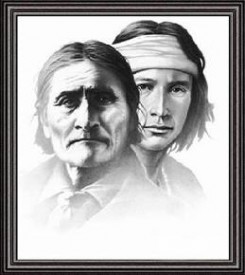Geronimo As Racial Stereotype
Racial stereotypes of American Indians were prevalent during the so-called Indian Wars and continue to this day. One example is the recent code name Geronimo that the US military used for Osama bin Laden. This is hurtful to Native Americans, many of whom find it inappropriate to link a Native American legend to perhaps the greatest enemy of the United States. The Staff Director and Chief Counsel for the Senate Indian Affairs Committee said: “These inappropriate uses of Native American icons and cultures are prevalent throughout our society, and the impacts to Native and non-Native children are devastating.”
More than anything else, Geronimo personified the Native ingenuity and resilience that so characterized many Indian Chiefs, tribal leaders, and warriors in their fight for survival against the U.S. military and greedy settlers. Although Geronimo was demonized by the American media and seen by some as the perpetrator of “unspeakable savage cruelties,” to others he was the mark of proud resistance. A man of true integrity, once given, he kept his word at any cost. This was the opposite of his experience with the U.S. military and government. Thus, when the fighting was over, Geronimo is said to have told a relative that if he had it do do over again he would fight to his last breath. Geronimo was fighting for the basic freedom and Constitutional rights that Americans cling to today. We choose how we live and where we live. These rights as well as freedom of speech, the right to speak in their Native tongue, the right to bear their true name, and the freedom to practice a religion of choice were taken away from Geronimo and American Indians as a whole, and simply being born “Indian” was deemed to be “less than” by the Western system.
Before Geronimo became the warrior he was in the end, he was a family man whose wife and children were brutally murdered out of greed and prejudice. Sadly, some 400 years later, this stereotype and prejudice toward American Indians continues. It is up to each individual to get informed and to decide who and how they want to be toward American Indian people. One good way to begin is to order the PBS film, “We Shall Remain” or watch it online. Film 4 in this 5-part series tells the true story of Geronimo. The other films tell what really happened and why at Wounded Knee, in New England with the first Thanksgiving, and in the western expansion and pursuit of the railroad.


